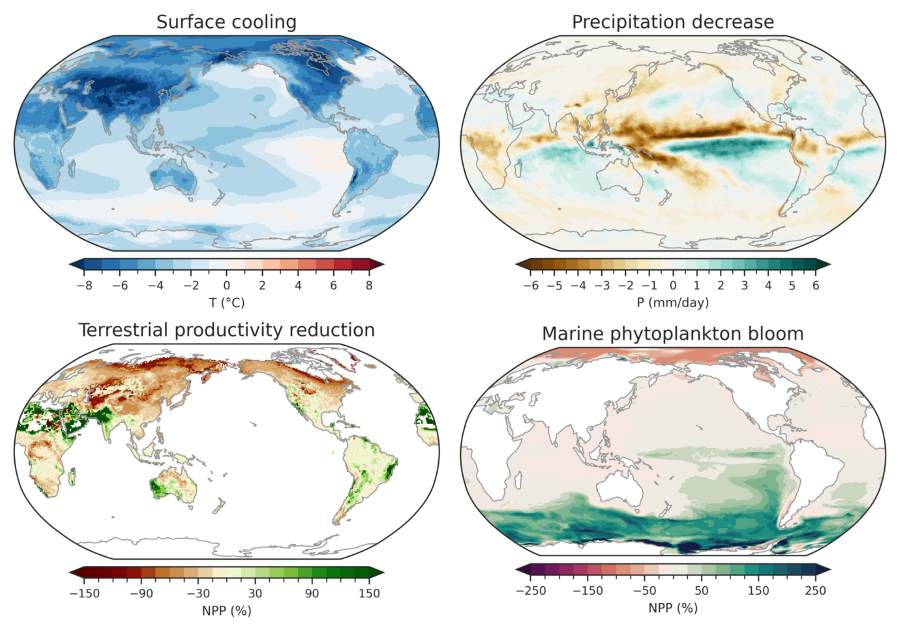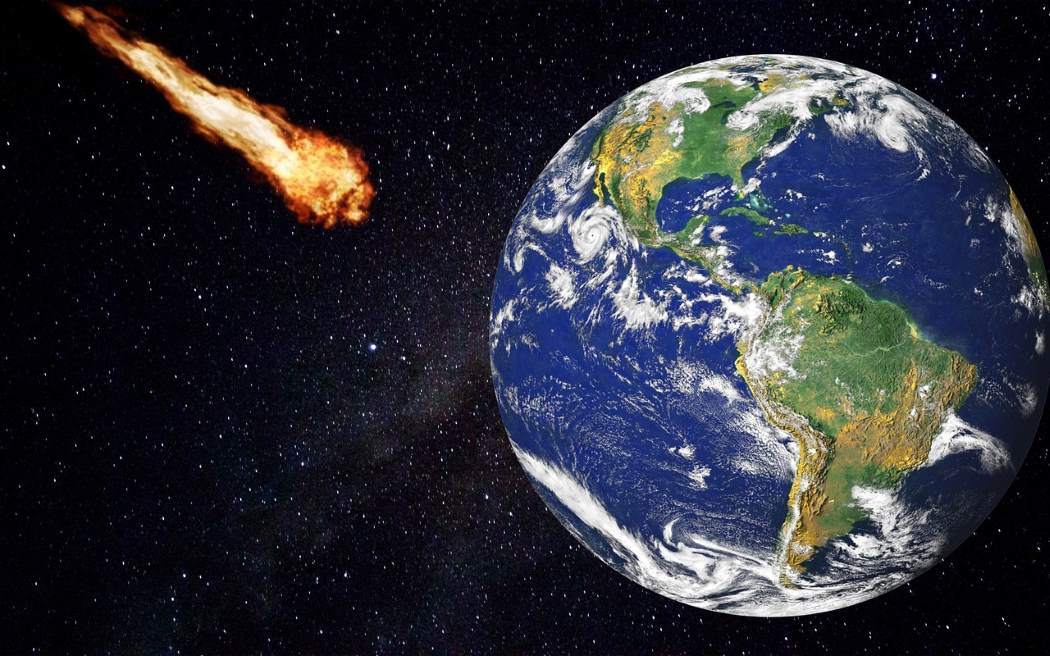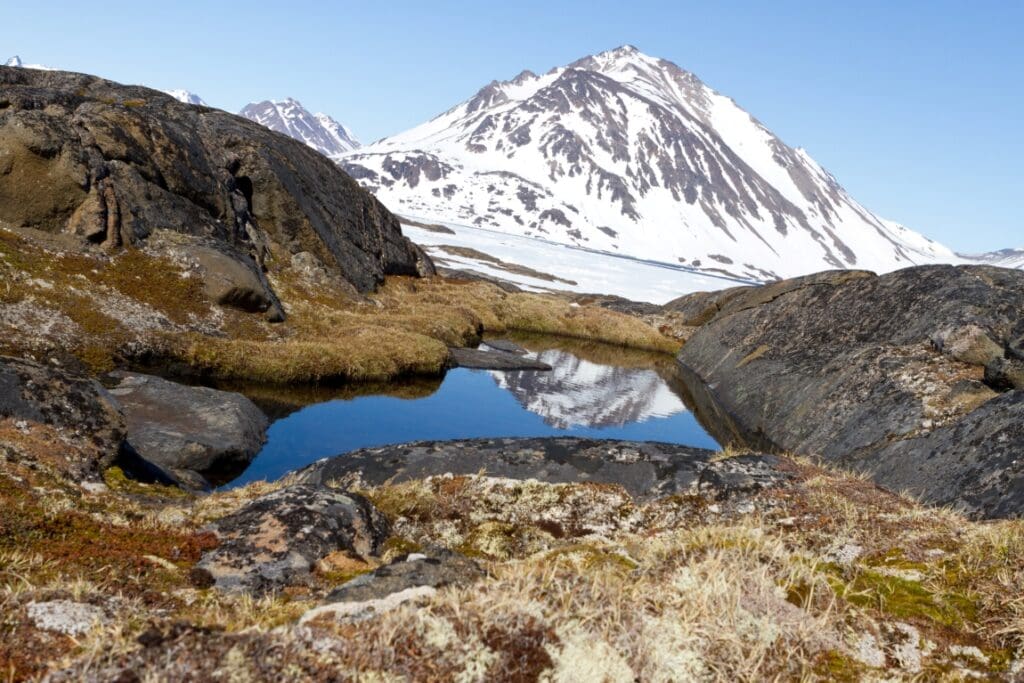Summary:
A new study published in Science Advances explores the potential consequences of a medium-sized asteroid strike on Earth’s climate and ecosystems.
Researchers from the IBS Center for Climate Physics (ICCP) at Pusan National University in South Korea used advanced climate models to simulate the effects of a 500-meter asteroid impact, injecting hundreds of millions of tons of dust into the upper atmosphere.
Their findings suggest a significant drop in global temperatures, up to 4˚C, along with reduced rainfall and severe ozone depletion. These changes would severely impact plant growth on land, with a 20–30% reduction in photosynthesis, potentially leading to food shortages. However, ocean ecosystems showed a surprising response. Plankton, fueled by iron-rich dust from the impact, rebounded quickly, triggering massive algae blooms.
The research provides new insights into how asteroid collisions have shaped Earth’s past and could affect future biospheric stability.

Scientists simulate asteroid collision effects on climate and plants
The new climate modeling study presents a new scenario of how climate and life on our planet would change in response to a potential future strike of a medium-sized (~500 m) asteroid.
The solar system is full of objects with near-Earth orbits. Most of them do not pose any threat to Earth, but some of them have been identified as objects of interest with non-negligible collision probabilities. Among them is the asteroid Bennu with a diameter of about 500 m, which, according to recent studies [Farnocchia et al. 2021], has an estimated chance of 1-in-2700 of colliding with Earth in September 2182. This is similar to the probability of flipping a coin 11 times in a row with the same outcome.
To determine the potential impacts of an asteroid strike on our climate system and on terrestrial plants and plankton in the ocean, researchers from the ICCP set out to simulate an idealized collision scenario with a medium-sized asteroid using a state-of-the-art climate model. The effect of the collision is represented by a massive injection of several hundred million tons of dust into the upper atmosphere.
Unlike previous studies, the new research also simulates terrestrial and marine ecosystems, as well as the complex chemical reactions in the atmosphere.
Using the IBS supercomputer Aleph, the researchers ran several dust impact scenarios for a Bennu-type asteroid collision with Earth. In response to dust injections of 100–400 million tons, the supercomputer model simulations show dramatic disruptions in climate, atmospheric chemistry, and global photosynthesis in the 3–4 years following the impact (see Figure 1).
For the most intense scenario, solar dimming due to dust would cause global surface cooling of up to 4˚C, a reduction of global mean rainfall by 15%, and severe ozone depletion of about 32%. However, regionally, these impacts could be much pronounced.
“The abrupt impact winter would provide unfavorable climate conditions for plants to grow, leading to an initial 20–30% reduction of photosynthesis in terrestrial and marine ecosystems. This would likely cause massive disruptions in global food security,” says Dr. Lan Dai, postdoctoral research fellow at the ICCP and lead author of the study.
When the researchers looked into ocean model data from their simulations, they were surprised to find that plankton growth displayed a completely different behaviour. Instead of the rapid reduction and slow two-year-long recovery on land, plankton in the ocean recovered already within 6 months and even increased afterwards to levels not even seen under normal climate conditions.
“We were able to track this unexpected response to the iron concentration in the dust,” says Prof. Axel Timmermann, Director of the ICCP and co-author of the study. Iron is a key nutrient for algae, but in some areas, such as the Southern Ocean and the eastern tropical Pacific, its natural abundance is very low. Depending on the iron content of the asteroid and of the terrestrial material, that is blasted into the stratosphere, the otherwise nutrient-depleted regions can become nutrient-enriched with bioavailable iron, which in turn triggers unprecedented algal blooms.
According to the computer simulations, the post-collision increase of marine productivity would be most pronounced for silicate-rich algae — referred to as diatoms. Their blooms would also attract large amounts of zooplankton — small predators, which feed on the diatoms.
“The simulated excessive phytoplankton and zooplankton blooms might be a blessing for the biosphere and may help alleviate emerging food insecurity related to the longer-lasting reduction in terrestrial productivity,” adds Dr. Lan Dai.
“On average, medium-sized asteroids collide with Earth about every 100–200 thousand years. This means that our early human ancestors may have experienced some of these planet-shifting events before with potential impacts on human evolution and even our own genetic makeup,” says Prof. Timmermann.
The new study in Science Advances provides new insights into the climatic and biospheric responses to collisions with near-Earth orbit objects. In the next step the ICCP researchers from South Korea plan to study early human responses to such events in more detail by using agent-based computer models, which simulate individual humans, their life cycles and their search for food.
Journal Reference:
Lan Dai, Axel Timmermann, ‘Climatic and ecological responses to Bennu-type asteroid collisions’, Science Advances 11, eadq5399 (2025). DOI: 10.1126/sciadv.adq5399
Article Source:
Press Release/Material by Institute for Basic Science
Featured image credit: Pixabay




